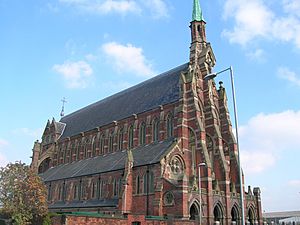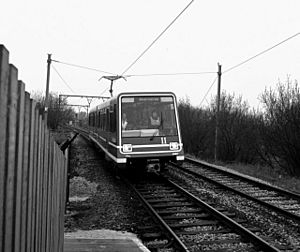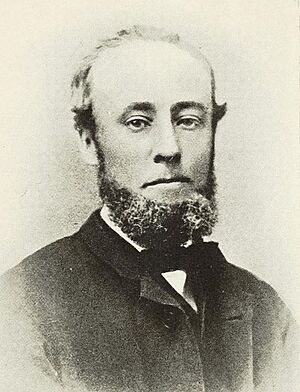Gorton facts for kids
Quick facts for kids Gorton |
|
|---|---|
 Gorton Monastery |
|
| Population | 36,055 (2011) |
| OS grid reference | SJ885965 |
| Metropolitan borough | |
| Metropolitan county | |
| Region | |
| Country | England |
| Sovereign state | United Kingdom |
| Post town | MANCHESTER |
| Postcode district | M18 |
| Dialling code | 0161 |
| Police | Greater Manchester |
| Fire | Greater Manchester |
| Ambulance | North West |
| EU Parliament | North West England |
| UK Parliament |
|
Gorton is an area in the city of Manchester, located in Greater Manchester, North West England. It is found to the southeast of the main Manchester city centre. In 2011, about 36,055 people lived there. Nearby areas include Levenshulme and Openshaw.
A very important building in Gorton is Gorton Monastery. It's a beautiful 19th-century building that used to be a Franciscan friary (a type of monastery).
Contents
Discovering Gorton's Past
How Gorton Got Its Name
Some local stories say Gorton got its name from "Gore Town." This was supposedly after a big battle between the Saxons and Danes long ago. However, historians don't think this is true.
The name Gorton most likely means "dirty farmstead." It might have come from the Gore Brook, a small stream that still flows through the area today. The brook may have looked dirty because of peat or iron in its water.
Gorton in Medieval Times
In the Middle Ages, Gorton was a small part of the large ancient parish of Manchester. This was in a region called the Salford Hundred within Lancashire.
The Birth of Manchester City F.C.
Did you know that Manchester City F.C. started in Gorton? It was first called St. Mark's (West Gorton) and began in 1880. The club was created to bring the local community together. It also aimed to help stop "scuttling," which was a type of gang fighting in the 1870s.
Anna Connell, the rector's daughter, is often given credit for starting the club. But William Beastow, a churchwarden, played a big role in creating sports activities for the church area. A cricket club, St. Mark's Cricket Club, was playing in 1875. This club later turned into the famous football club. Their first recorded football game was in November 1880.
Charging Thunder: A Unique Story
In 1903, a Blackfoot Sioux chief named Charging Thunder came to Salford. He was 26 years old and part of Buffalo Bill's Wild West Show. Like many Lakota tribesmen, Charging Thunder was an amazing horse rider. He performed exciting stunts for huge crowds. These shows took place where the Lowry is now in Salford Quays.
When the show left town, he stayed in England. He married Josephine, an American horse trainer, and they had a child named Bessie. They first lived in Darwen before moving to Gorton. Charging Thunder changed his name to George Edward Williams. This helped him find work after registering with British immigration. Williams became an elephant keeper at the Belle Vue Zoo. He passed away on July 28, 1929, at 52 years old. He was buried in Gorton's cemetery.
Gorton's Economy and Development
Work and Industry in Gorton
The Industrial Revolution brought many jobs and factories to Gorton. One famous factory was Beyer, Peacock & Company, which made locomotives (train engines). Today, these sites still provide jobs in many different areas. This includes local businesses and big national companies like Iceland.
Many people also work in shops and entertainment places. For example, Space Studios is a TV and film production studio. It employs up to 300 people. Gorton is less than 3 miles from Manchester city centre. So, many people who live in Gorton also travel to the city for work.
Filming Locations and New Projects
The popular TV show Shameless was mostly filmed in West Gorton. The shops used for filming were built where St Mark's Church used to be. This church was the birthplace of Manchester City F.C..
This area has now been completely rebuilt. There are new homes, a new Medical Centre, and new shops. The "Space Project" is also there. It's a large studio with six sound stages. Many BBC and ITV shows are filmed there.
Modernizing Gorton's Shopping Centre
In 2006, Manchester City Council began a huge project to redevelop the Gorton District Shopping Centre. The old market and shops were taken down. In late 2007, work started on a new market hall and a large Tesco Extra supermarket.
The new Manchester Gorton Market Hall opened in July 2008. The new Tesco Extra store and its petrol station opened in late October 2008. More shops have also opened along Hyde Road, like Subway, Coral, and Age UK. These changes are making Gorton "an even better place to live and work." Old tower blocks have been removed, and new homes and parks are being built. House prices are going up as more people want to live in the area.
Gorton's Geography and Landmarks
Local Areas within Gorton
Belle Vue is a part of Gorton. West Gorton became part of the City of Manchester in 1890. The rest of Gorton joined the city in 1909. This was largely thanks to Councillor Joseph Henry Williamson.
Abbey Hey is another area within Gorton. It is mostly a place where people live. It is also known for Wright Robinson College.
Important Buildings and Sites
Gorton is famous for Gorton Monastery. This 19th-century building was a Franciscan friary. It has been beautifully restored and is now used for other purposes. It was empty for a while after the friars left. The local Catholic churches, St Francis of Assisi and Sacred Heart, now form one parish.
Other notable churches in Gorton include the Brookfield Unitarian Church on Hyde Road. It was built by Richard Peacock. The Mount Olivet Apostolic Church on Mount Road was built by Walter Tapper in 1927.
The Gorton District Shopping Centre was redeveloped starting in 2006. A new market hall and a large Tesco Extra supermarket opened in 2008. More shops like a Subway and Coral bookmakers also opened nearby.
Getting Around Gorton: Transport
Train Stations in Gorton
Several train stations serve the Gorton area. These include Gorton, Ashburys, Belle Vue, and Ryder Brow.
Trains on the Hope Valley line and Glossop line stop at Gorton station. These trains are run by Northern. You can catch trains to Manchester Piccadilly, Glossop, Hadfield, and Rose Hill Marple. Gorton station is even mentioned in the 1964 song Slow Train by Flanders & Swann.
A Look Back at Gorton's Railways

Another old train station in Gorton was Hyde Road. It opened in 1882 on the Fallowfield Loop railway line. This route stopped carrying passengers in 1958. The station had a brief return in 1987. It was used to show how the Manchester Metrolink system might work. A temporary station called Debdale Park was built there. A special light rail vehicle from London was driven on a short track. This showed how the new tram system would look. Soon after this, the Fallowfield line was taken apart. It is now a walking and cycling path called the Fallowfield Loop.
Making Locomotives in Gorton
A company that became famous for making locomotives was started in Gorton in 1854. This company was called Beyer, Peacock & Company. Its owners were Charles Beyer, Richard Peacock, and Henry Robertson.
Richard Peacock used to be the chief engineer at another locomotive factory nearby. He saw a chance for a private company to build train engines. One early success was making the world's first successful steam condensing locomotives for underground railways. They built 148 of these. Later, in the 20th century, the company designed and built over 1,000 powerful trains called Garratts. By the time the company closed in 1966, it had built almost 8,000 steam and diesel locomotives.
How Gorton is Governed
The city of Manchester was created in 1838. Part of Gorton became part of the city in 1890. The rest of Gorton became its own local area in 1894. A small part of this area was moved to Manchester in 1901. The remaining part was fully joined into Manchester in 1909.
Gorton is part of the Manchester Gorton parliamentary constituency. This area includes Gorton North, Gorton South, Fallowfield, Longsight, Levenshulme, Rusholme, and Whalley Range. After changes in 2018, the Gorton area is now covered by one local voting area called Gorton and Abbey Hey.
Sir Gerald Kaufman was the Member of Parliament (MP) for the Gorton area for 47 years until he passed away in 2017. The current MP for Manchester Gorton is Afzal Khan. After new changes for the 2024 General Election, the area will be part of the Gorton and Denton constituency.
Arts, Culture, and Sports in Gorton
The Gorton Philharmonic Orchestra started in 1854. It is an orchestra made up of amateur musicians. The comedy group Gorton Tank was based in Gorton and was very popular in Manchester. The painter Michael Gutteridge was born in Gorton. The Gorton Morris Men helped bring back the rushcart ceremony in Gorton.
As you know, Manchester City F.C. was founded as St. Mark's (West Gorton) in 1880. The Abbey Hey F.C. football club is also in Gorton. "Bouncing Billy Barker" was a local man known for his amazing jumping skills. The current champions of Britbowl (as of 2023) are the Manchester Titans, an American football team based in Gorton.
Gorton's Folklore Traditions
John Higson (1825–1871) was a historian from Gorton. He wrote about old beliefs in the mid-1800s when Gorton was still a rural area. He described many local boggarts, which are like mischievous spirits. These included:
- Nell Parlour Boggart, described as "rough and hairy, with eyes as big as saucers."
- Gorton Field Boggart.
- Green Stile Boggart.
- Ho' Lane Boggart, which could appear as "a dog, hare, rabbit, or other small animal."
There was also a Boggart House, which was a haunted house. According to Higson, people often found "fairy rings" (circles of mushrooms) and "fairy pipes" (tiny old pipes) in the countryside around Gorton. Higson also wrote a poem about a boggart in the local dialect. It was called 'Th' Boggart O' Gorton Chapelyord'.
Famous People from Gorton
Many notable people have connections to Gorton:
- John Thaw, an actor famous for playing Inspector Morse, was born in West Gorton.
- Samuel Birch (military officer)
- Billy Meredith, a former footballer, lived on Clowes Street and got married at St Mark's Church.
- Tommy Johnson, a former footballer for Manchester City F.C., lived in Gorton.
- Nicky Butt, a former England and Manchester United footballer, was born in Gorton.
- Bob Berry, a former England and Lancashire cricketer, was born in Gorton.
- Jeff Williams, an Olympic cyclist in 1980, was born in Gorton.
- Thomas Evenson, who won a silver medal in the 3000 meters steeplechase at the 1932 Summer Olympics in Los Angeles, was born in Gorton.
- George Wilkinson, who won three Olympic gold medals in water polo, was born in Gorton.
- Brian Statham, a former England and Lancashire cricketer, was born in Gorton.
- Samuel Gorton, an early settler of North America and the fifth President of Rhode Island, was born and grew up in Gorton in the 1590s.
- Roger Byrne, a Manchester United player who sadly died in the Munich Air Disaster, lived on Wistaria Road in the 1940s and 50s.
- Meekz, a rapper, was raised in Gorton.
- Nemzzz, a rapper.
- John Higson (1825–1871), the historian mentioned earlier, was born into a farming family in Gorton.



